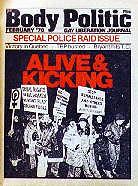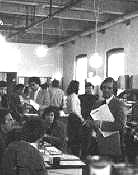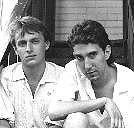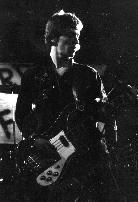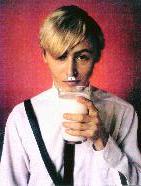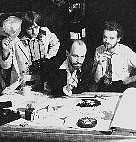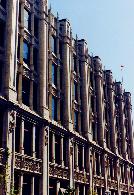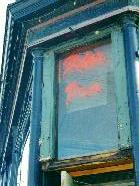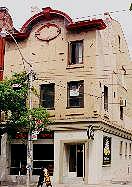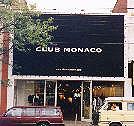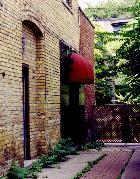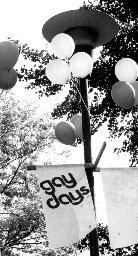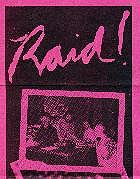|
Promiscuous |
|
Alive & kicking (& spinning)
Post-raid promo:
|
Support poured in, gay & otherwise, from across the country & beyond. San Francisco's Harvey Milk urged a tourist boycott of English Canada.
Not all comments were kind. The Toronto Sun called TBP "a crummy, dirty publication without a redeeming feature." We'd use that line in subscription promo.
1978
There was plenty of excitement in the weeks following the raid. We began by putting those luckily discovered computer cards to quick use. It was Don Bell (my erstwhile fuck buddy; a TBP collectivist in 1973) whose job it was to run them through his machine at work to produce lists and labels. Within days he had. We got out a mailing right away.
In less than a month we got back more than $12,000 in donations. This would be the backbone of The Body Politic Free the Press Fund, legally and financially independent of the paper: only five of its 10 directors were from the collective; the money it raised was held in trust by a lawyer, available only to cover legal costs. Not a penny was ever tapped for TBP's operating expenses.
Issue 40, dated February 1978, appeared a few weeks late but did appear, its cover banner: "Special Police Raid Issue." On the back was a "Search and seizure subscription special: 1 for the price of 2." That issue was smaller than usual, just 24 pages to the usual 32 or more of that time. It had no reviews, only a few columns, but was otherwise full of goodies.
The news began with a splash, "Gay rights: oui!" On December 15, 1977 the Quebec National Assembly had voted to cover sexual orientation in its human rights charter, the only such jurisdiction then to provide sweeping legal protection for gay people.
The government had been moved by embarrassment: on October 21 police had raided two Montreal gay bars, Truxx and Le Mystique, toting machine guns and carting off 146 men -- the biggest mass arrest since the October Crisis of 1970 (a record that would later be broken, in Toronto). Thousands poured into the streets in near riot two nights later.
The rights won in Quebec would become the prime focus of the entire gay movement across the country, not secured anywhere else in Canada for years to come.
Next: two pages on Anita Bryant's January visit to Toronto, imported by local evangelists -- and on her reception by gay men, lesbians, feminists, and newly self organized gay youth. More than 500 people picketted The People's Church in a far suburb and in freezing cold the night Bryant spoke there. More than 1,000 were at an earlier rally at the St Lawrence Market.
There, we could not take for granted any knee jerk support for The Body Politic. Many feminists had been deeply offended by "Men loving boys loving men," seeing the raid as no more than what we dirty boys deserved. Not a few gay men agreed. It took a heterosexual woman, journalist Joanne Kates, to turn things around.
In the January 4 Globe and Mail she had written: "To press obscenity charges against one issue, was it necessary for police to seize things like subscription lists?" In a passionate speech at the rally, she made it clear that this police action targetted gay people beyond the paper's walls. Two guys from Gay Youth Toronto, passing out promo on Yonge Street the night before, had been harassed by police then followed into The Parkside, arrested for "loitering."
Wary of making ourselves the lead story (though we'd inevitably end up in our own news pages for years to come) we held off 'til the third spread to report the raid on TBP. On January 5, 1978, charges had been laid against Pink Triangle Press, the paper's nonprofit corporate presence set up in 1975, and its three directors -- roles meant to be no more than nominal, until now: Ed Jackson, Gerald Hannon and Ken Popert.
Our press conference that day, like one we held just after the raid, was packed. Messages of support came from the Canadian Civil Liberties Association and other groups, gay and not, across the country and beyond. There were protests at Canada House in London, in Los Angeles, and in San Francisco, where newly elected gay city supervisor Harvey Milk urged a tourist boycott of English Canada.
Not all missives were so kind: the day after the raid The Toronto Sun ran an editorial, titled "Depravity," saying that the notion of the police raid having anything to do with freedom of the press was "balderdash." TBP was, The Sun opined, no more than "a crummy, dirty publication without a redeeming feature."
With some glee, we'd use that line in subscription promo. Our trial would not come for another year.
Weekend's 1977 photo spread -- with its subjects' activist credentials duly noted -- appears in Giving it away: The Body Politic & life in a culture of gifts.
Weekend wanted "just average gay people": no one working for a gay business; no "professional homosexuals." Ian himself was in that picture -- co-founder of UTHA, the University of Toronto Homophile Association, founder of Canada's only gay publishing house, Catalyst Press, and a columnist for The Body Politic. Of the 22 people pictured just two, one a babe in arms, the other sociologist Edgar Friedenberg, were not involved in the gay movement (Edgar later would be). There was Charlie Hill, another co-founder of UTHA; Michael Lynch, Bill Lewis, David Gibson, Ed Jackson, and Chris Bearchell.
Chris was a frequent author of TBP's Dykes column, around the paper often and later there all the time, as a member of both staff and collective. At times she was the only dyke there, hugely influential in the life of the paper.
Weekend's caption cast people there only as professor, scientist, engineer, etc -- with no mention of their activist careers. We had some fun with it, offering up all the incriminating details.
"Why are these people smiling?" we asked at the end. "Take a guess."
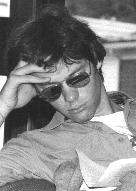
"You can tell when
|
|
Boys of Queen West
Tim Guest:
Glenn Schellenberg
How'rd Pope:
Wholesome:
|
|
Really Big Boys of Queen West
General Idea:
"We wanted to be famous, glamorous and rich. That is to say we wanted to be artists, and we knew that if we were famous and glamorous we could say we were artists and we would be. We did and we are. We are famous, glamorous artists." |
|
Queen West then
Modern views,
Queen West now
Lost dreams:
|
|
Buddy's "Backroom" yak
Glam in front,
|
He never did practise law, his lateral mind uncomfortable with cold Cartesian logic. Later on the collective, he'd drive Michael Lynch -- not to mention that coolly rational former Communist Ken Popert -- to sheer distraction.
Robin would write about everything from radical faeries to the films of Kenneth Anger; from circumcision to "homosexual murder, " a media term tossed around whether the assailant, the victim, or in one case possibly neither, was gay.
He would later live in Paris and Berlin; by 1985, New York. He'd write blood & guts adventure stories for men, using a nom de plume, common practice in the genre. Some of his other works clearly required one: Hardy Boys stories -- a real Hardy boy writing them.
He was big featured, effusive -- hugely sexy. He lit up the office (someone once said "you can tell when he's in the room") and not a few of its inhabitants' beds, once or twice my own.
But of all the things in that issue, my favourite was a small photo of a young man speaking at that anti Anita rally: Tim Guest. Tim was symbolic of a fresh turn in the life of The Body Politic, and in my own.
When TBP took 24 Duncan in May 1976, the neighbourhood had seemed nothing special: big warehouses south of Queen, the street full of used furniture stores, taverns, greasy spoons, ratty apartments above, and the huge wedding cake of the Wesley Building, home of the United Church's Ryerson Press. The area's main attractions had been plenty of small printers for flyers and such, photostat houses, a few decent copy shops -- and lots of big, cheap space.
It was the availability of such space that would transform Queen West. It was cheap enough for other marginal types like us, in particular artists and musicians looking for places to create, rehearse, display their works -- and live.
New styles were taking hold. In late 1976 the city's first punk rock club, The Crash 'n' Burn, opened down at 15 Duncan. The Centre for Experimental Arts and Communication, in the same building, would later get into trouble familiar to us at TBP, their publication Strike shut down for ostensibly supporting knee capping by the Italian Red Brigades.
New bands variously punk, New Wave, or suburb send up silly played at some of those taverns: the Beverley; the Horseshoe; the Cabana Room at the Spadina Hotel. The Wesley Building, ditched by the United Church, soon held galleries, studios, the offices of small radical magazines, and the Working Skills Centre, training immigrant women.
In just a few years Queen Street West went from nothing special to the city's most notorious cultural hotbed, its very name evoking a certain distinct style: cool, irreverent, and sexually ambiguous. Its theme colour, worn by everyone, was black.
The area's most famous artists were General Idea, a trio of gay men working as a collective, their individual names not on their art but those names well known. Or their adopted names: A A Bronson (aka Michael Tims), Felix Partz (or Private Partz; Ron Gabe), and Jorge Zontal (Jorge Saia).
They'd been together since 1968, their 10th anniversary celebrated this year with a big bash atop the CN Tower. They published a magazine called FILE, its logo a parody of LIFE's -- for which they would nearly be sued. GI would last 26 years and go on to international acclaim.
But for the moment they could be found around Queen West, having moved from very odd digs at 241 Yonge to 217 Richmond West at the corner of Duncan, just up the street from us. Their space also held Art Metropole (original 1911 name of 241 Yonge, now a Taco Bell), an artists' archive and resource centre, and in time Centerfold magazine, later FUSE, run by among others musician and composer Clive Robertson and his partner, video artist Lisa Steele.
Their magazine would give The Body Politic's trials even more coverage than TBP did itself. Artists knew about censorship, about the fragile state of free expression, and -- gay or straight, in fact mostly the latter -- they would be among our most vocal political allies. In turn, TBP attended to the local art and music scene in ways unlikely had it lived anywhere else.
That accidental move in 1976 would long shape the paper's sense of cultural and even sexual politics.
At 217 Richmond one often found Tim Guest. He was Felix Partz's boyfriend, 22 then, not long in town from Winnipeg, with the Revolutionary Workers' League, and an avidly activist "gay youth." The youth movement was so strong then that the correct mantra for naming homosexuals collectively was "gay men, lesbians, and gay youth."
With its May 1978 issue TBP started a column (one of a few devoted to distinct constituencies) called The New Age, meant for young writers. "New Wave Nurse" Billy Sutherland appeared there, as did Glenn Schellenberg, playing with various Queen Street bands. But the first New Age was by Tim Guest.
I was his old fart editor, all of six years his senior. It could be an awkward assignment, Tim's style coloured by art world bafflegab and deconstructionist jargon just then gaining (rather limited) currency. But I enjoyed Tim and in time learned to step back in favour of his voice, quite a distinct one.
"I want to write about my body," he began that first column, "to outline some thoughts about young gay men -- about our bodies as objects and as the form of our oppression." He called it "Image control," illustrating it with an image of himself: fiercely skeptical in a leather jacket, dragging on a cig.
The image, captioned "Modern sculpture," had an extended credit: "Art direction: Felix Partz; hair: Tish Aldridge; jacket: Paris Motobike. Photo by Rodney Werden." Tim looked fabulous.
He always looked fabulous: shining black hair; intense eyes in that boyish, fine featured face; a neat, trim little body. He was, in life as well as images, the very picture the smart young thing. Very smart, in every sense. Somehow I felt he always would be. In the mid '80s Tim would move to New York, working in galleries and on artists' books.
In late 1998 the Power Plant Gallery would do a great exhibition, "Picturing the Toronto Art Community: The Queen Street Years," capturing the magic of a place and time full of people who were artists because they said so -- and did the work to prove it. I'd see Tim there, dancing in a video, in his usual skinny black tie.
Later at Pages Bookstore on Queen I'd see him again, in an issue of FUSE: a picture of him. And his dates: 1956 - 1998. He had died that April. I'd had no idea.
By then, the Queen Street we'd known was a lost dream, its cheap storefronts gone to The Gap, Club Monaco; the Wesley now the CHUM City Building, home to City TV, MuchMusic and Bravo! It was a mecca for tourists, not artists. They had long fled a mile or more west, to cheaper rents.
But it was in that moment, looking at that picture of Tim, still stunning in it, that I suddenly, sharply, felt that loss.
I don't recall exactly when, but my days at The Body Politic soon became nights. The gang had often worked 'til dawn getting issues to bed; I made it a regular practice. Beginning 10 days before each press date I'd sleep in the daytime and go in around 7 pm, staying until 7 am or beyond. I got more done that way, the typesetter and layout tables all to myself and, at last, no jangling phones.
I'd continue this routine well into the mid '80s, with unsurprising consequences for any night time social life. But in time I did have company. Others saw the same benefits so I was rarely alone, a few people also working away. On occasion, just one.
That, too, could have its benefits. Sex wasn't rare in the office (imagine trying to stop it, as most workplaces do): on its big flat roof; in the freight elevator. I didn't bother with those; even the loo seemed gratuitous. The shipping room would do, once I recall during the day, the sofa near the front desk at night.
I did fail to grasp my most blatant opportunity. One night Smee Holzberg, a very sexy volunteer, got up from his typewriter looking antsy, jumped up on the big production table in front of me -- and took down his pants.
"Ricky" (that's what I got called at the paper), "do I have crabs?" I checked, none there. Much else was and wonderfully, but I left it at that -- even though he'd once offered it to me half erect in the can, if then just for a squeeze.
In time the wider world would see Smee's cock, he sprawled naked in a May 1981 layout for a news story. A decent way to sell news, I thought, especially when it was news about sex -- as by then it very much would be.
My more usual diversion was the Beverley Tavern, up on Queen, a break around 11 pm to go see bands upstairs. Billy Sutherland often went with me, "unofficial president" of the Drastic Measures fan club, I his "confidante" -- titles bestowed by lead singer Tony Malone.
Their signature tune was an eerie take on "The Teddy Bears' Picnic." I also liked "Don't Play with TNT, Play With Me," Tony substituting "Timmy Guest" for "TNT" whenever Tim was there to hear it.
Drastic Measures was mixed: Tony was gay, as was How'rd Pope, cute 17 year old baby brother to Carole, who with her group Rough Trade was more famous. But the other musicians were not. Such definitions didn't much matter there, the crowd at The Bev also mixed, as was the whole Queen Street scene.
This could confound more traditional homosexuals, even activist ones. Ken Popert remained deeply suspicious of this much touted "ambiguity," seeing it as a trendy brand of closetry. For some it was. Others were truly ambiguous, and some simply hadn't yet figured things out.
A sharp eye at The Bev could serve one well, once past expecting obvious signs. I met a sweet kid there, maybe 19; between sets he sat reading Susan Sontag's Against Interpretation. We had a brief affair but soon he was scooped up by Tony Malone. In 1979 I'd meet my next lover at The Bev.
Glenn Schellenberg wrote about Tony and his band for TBP. When they released an album later, I'd review it. Glenn ended up on The Body Politic's cover in 1981 as one of the four boys in a band, another of them Paul Hackney, who would be with TBP for years.
That group, TBA, was famed for its blessed absence of macho guitar play (for that matter any guitars at all). It nearly had another name: Present Tense. Glenn had seen a few musical monikers come and go. He'd been with The Everglades, known for a rousing number called "I'm in a Coma"; before that The Dishes. They liked hoisting a poster of Farah Fawcett Majors, to which band and audience shouted in unison: "Faaa- rah -- No!"
Some of The Dishes could be found carting real dishes, waiting tables at The Peter Pan, a dingy Chinese restaurant turned the height of Queen Street attitude. Their record jackets were art directed by General Idea.
Billy and I saw Glenn in all his incarnations. And often with Glenn -- who always liked to say, "Sooo... you wanna go hang out?" -- we'd catch Martha and the Muffins (their "Echo Beach" a big radio hit), sometimes The Diodes, also Peter Panners, and often The Biffs.
They were cute boys from Scarborough (a suburb; aka Scarberia). One of their numbers began: "Attention shoppers aisleway one! Attention shoppers aisleway one! Jiff 'n' Fluffernutter, law- aw- awts of fun! Charlie the Tuna wants to dah- ah- ie today" -- and on and on it went.
Such was life at The Bev. You can tell I loved it.
In May we got another place to hang out, though one clearly gay, so not quite as zany. Buddy's was in the back half of a basement at 64 Gerrard Street East, its door on a laneway running off Church. The front of that basement, entered more grandly from Gerrard, was Crispin's, a fine restaurant, both under the same management.
Key partners included George Hislop and his lover Ron Shearer, George trying his hand at another gay venture: he was also part owner of The Barracks bath, opened in the mid '70s much deeper downtown. He would go on to run other bars in the '80s, even into the 1990s.
Buddy's marked a shift in the geography of Toronto's gay scene, from Yonge over to Church Street. It wasn't the first place to open on (or in this case just off) Church. Janko Naglic, with The Quest in its early days, and his business partner Freda Groves had taken over Les Cavaliers, a restaurant just up the street, and by 1975 were cultivating a gay clientele.
In 1976 they'd opened its second floor as a dance club. It was called Jo Jo's at first, its clientele mostly lesbians -- until a few in jeans were kicked out. By 1977 it was The Barn, looking for men into leather and denim.
In its early years it could feel a distant outpost, in both geography and style. Buddy's gave it company, nearby and more eclectic. This was the beginning of a critical mass that in time would explode into a great raft of gay businesses on Church Street.
The site of Buddy's, behind Crispin's (and not a little promo hype), led it to be advertised as a "backroom bar." But the usual connotations of "backroom" hardly applied. The place cultivated the one thing backrooms meant for sex never did: talk.
The music was low enough to allow it; George, natural publican and aspiring politician, was happy to take part. A bulletin board at the foot of the stairs was always covered in community notices, rare in gay venues until then. The U shaped bar in the middle created conversational spaces on each side, one small but open, the other bigger and with tables.
There was no dance floor but there was a pool table, in a nook created by the stairwell. There and elsewhere beer crates were stacked along the walls, seat high and covered with stretches of plywood so you'd feel free to plunk down.
Buddy's became an institution, practically a community centre. The CHAT Centre on Cecil Street was a lost memory, having barely survived 1972. Its replacement was less divine -- unless you could get off on the Catholic bishop's palace across the street: the second floor of a small building far south, at 201 Church.
CHAT held dances there but they had none of the magic of Holy Trinity. The place came to be regarded as a haven for the walking wounded -- though I once met someone there quite lively and, with him, found the big flat roof quite convenient.
By 1977 CHAT itself had faded away. With Buddy's, George Hislop found a more successful mix: politics and commerce. The thing most often said about Buddy's was that it was friendly. Dudes was certainly gay friendly, more so than any place before, but Buddy's was less rigid in style, its ads not suggesting strict appeal to a limited clientele.
And it certainly wasn't limited: there were men and women -- though mostly men; there were polite older gents and working class kids in tight jeans, possibly hustling -- though that was discouraged. There were clones, preppies, the occasional drag number and lots of community politicos.
Buddy's was where we Beepers went to yak -- often about The Beep, as usual, but with a much wider crowd of yakkers. We hung out there to hear how we were doing.
Alan Turing,
& With Downcast Gays
Andrew is now at Oxford & has his own website. Links there lead to info on Alan Turing & to the full text of With Downcast Gays. For Andrew's reflections on artificial vs human intelligence, see Sex: From erotic life to death by banality.
The Queen West scene
Art Metropole:
Glenn Schellenberg:
788 King St W, Toronto (416-703-4400). General Idea's resource centre, still extant.
"Disco muzak requires drastic measures." TBP, Sept 1978. Glenn on "the dry, on stage banter" of Tony Malone (born Anthony Seeley), bringing home "the point of his gayness."
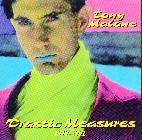
Drastic Measures, 1979-1992:
|
Doug Durand & Martha Fleming:
David Vereschagin:
Rosemary Donegan:
Gary Indiana:
"Video is not Television, Performance is not Theatre." TBP, Jun 1980.
Featured on the cover (artist Colin Campbell as a stunned punkette in his video Bad Girls), this piece looked at works by General Idea, Elizabeth Chitty, John Greyson, Lisa Steele, Martha Rosler, & The Clichettes. The authors, artists themselves, were TBP regulars.
"What's the Big Idea?" TBP, Jun 1985. A 4-pg interview with General Idea, covering some of their best known works.
"What Ever Happened to Queen St. West?" FUSE, Fall 1986. The rise & fall of an artists' nabe, with a look at earlier local scenes also long gone (as ever, to rising rents).
"From Love to AIDS: The Death & Life of General Idea." The Village Voice,, Dec 5, 1995. A A Bronson going on alone, Felix Partz & Jorge Zontal dead of AIDS in 1994. The title refers to GI's 1987 "AIDS" logo, a lift of Robert Indiana's "LOVE" of the '60s.

Hemmed in by AIDS:
|
Rick Bébout:
Diva Diaries. More on Carole Pope, her "baby brother" Howard Pope, General Idea, & Tim Guest.
|
Time to party
Gaydays, Aug 1978:
|
Lorna Weir
& Mariana Valverde
Graduate students in their early 20s, both came to TBP from the women's movement, socialist feminist wing. You can find them (among many others, Chris Bearchell included) in The House That Jill Built (U of T Press, 1995), Becki Ross's history of LOOT. They're now university professors, both still active in community work.
Mariana's books include: Sex, Power & Pleasure (Women's Press, Toronto, 1986) & The Age of Light, Soap, & Water: Moral Reform in English Canada, 1885-1925 (McClelland & Stewart, Toronto, 1991). The former was reviewed in TBP's very last issue (Feb 1987) by Anna Marie Smith -- of a later activist generation critical of their feminist forebears. Her piece was titled: "I'm okay, you're socially constructed." (But we're still friends.)
Paris was sublime if uneventful. I stayed with my brother Bill and his girlfriend Clare, she studying at the Sorbonne, he most often in the American literature section of that great pile of pipes, Le Centre Pompidou. They lived in the 10th arrondissement, off the tourist track; vintners and green grocers there just loved these two funny American kids. What I best remember is food, strawberries and tomatoes in their prime that Gallic spring, and a nice little neighbourhood place called La Brasserie Flo.
In London I stayed with Andrew Hodges. With David Hutter he had written With Downcast Gays: Aspects of Homosexual Self oppression, product of their work in the London Gay Liberation Front, first published in 1974. That little booklet had a huge influence on people at TBP. It was the first item the paper ever offered by mail order; in 1977 Pink Triangle Press published the first North American edition and would do a second in 1979.
I'd met Andrew in 1977, he on a visit to Toronto and already working on another book. I'd find myself underfoot of it that May, sleeping on a mattress pulled out on the floor of Andrew's living room, where he worked (or tried to). We did talk about his new project but, perhaps thinking Andrew a pamphleteer, I had no idea of its scope.
That book, Alan Turing: The Enigma, was published in 1983. Reading it then (even hefting it) I would be more embarrassed at having once lain in its way. It was vast, definitive, one of the most important works ever made possible by the modern gay movement.
Andrew had first heard of Turing in the GLF's Counter-psychiatry Workshop. He'd been a mathematician: inventor of concepts that led to the computer; key in creation of some of the first ever built, and in breaking Germany's Enigma Code during World War Two.
He had also been unapologetically homosexual. That fact had been tolerated while he was of use to Britain's national security state, but became dangerous in the American inspired Cold War witch hunts for Commies and fags in the '50s. Arrested once, he was forced onto estrogen therapy: he grew breasts. In 1954 he killed himself, making it look accidental to spare his mother.
Only an openly gay mathematician could have done Alan Turing biographical justice. And that's exactly what Andrew Hodges was. His book generated wide interest, including a play, Breaking the Code, and a film starring Derek Jacobi as Alan. Before Andrew, Turing's name had been nearly unknown. The 21st century will no doubt see him as one of the most influential men of his time.
I didn't bar hop in London this time, content with seeing a movie or two with Andrew and his roommates. More than content: they were lovely, one especially. He was a civil servant: striking in his blue pinstripes; at home in T-shirts and cutoffs big, succulent, easy going.
One night while I was helping him wash the dishes, he put his arm around me. I snuggled in. "I suppose," he said, "that we won't have to pull out your mattress tonight." Civil in bed, too -- if also deliciously wild. We purred and growled like cats in the jungle.
I also kept out of Andrew's hair by taking jaunts, the longest by train to Lewes, in Sussex, from there four miles on foot to Monks House in the village of Rodmell. Virginia Woolf had lived there much of her life, dying there in March 1941, stuffing stones in her coat pockets and walking into the River Ouse.
In the garden of Monks House a bust of her by Stephen Tomlin stands over her ashes, below it the penultimate line of her novel, The Waves: "Against you I will fling myself, unvanquished and unyielding, O Death!" Another bust stands nearby, of her husband Leonard, who outlived her by 28 years.
I knew all this but saw none of it, the house still in private hands. I walked along its garden wall, peeking over as I could, and sat in Rodmell churchyard writing postcards to tell people where I was. Some years later I'd be back. Twice.
New York wasn't much after that, just a day's stopover to visit Herb Spiers, now living there. I walked up Fifth Avenue, walked back down, then caught a plane to Toronto. But for a trip there in 1965 to sing with my high school choir at the World's Fair, that's all I've seen of New York. I would see London three more times.
I came back to more long nights and a big party. Production of the September issue went on concurrent with plans for that bash. Local Gay Pride fests had petered out in the mid '70s, though the growth of the community had not. People figured it was time to celebrate.
For five August days there were events all over town, a picnic for thousands at Queen's Park with displays from many groups, another one on Toronto Island and, on the last night, "The Biggest Gay Dance in the History of Toronto" (another record later broken), more than 1,400 there, 200 turned away.
It was work on our display that kept me up so long, that and the balloons and T shirts, both reading "The Body Politic. Pick us up." I was wiped. But I did get picked up. Or maybe I picked him up. Well, it doesn't matter.
Michael Christianson was up from Michigan State University, hanging around with another American boy, Eric, and Norman Laurila, a veteran of Glad Day who would go on to start the US gay book chain A Different Light. I first ran into them on the Island, Michael a combination of zany and laconic. And lanky: his jeans rode low on his otherwise naked torso, showing off very fine hips. I wanted those hips to ride me. And soon they did.
Michael and I later took to writing letters. I don't have mine but I do have all of his. In the first, its salutation "Mon cher M. Be Bop," he admitted to some hesitation that night I finally got him home. He had been hot for Eric.
- So, we go home together, and I think what have I gotten myself into.... I'm still not sure I want to do it with you. And then it all gets resolved very quickly....
Question: Did you intentionally move my hands to your head whilst you was blowing me? I was unsure so I sort of played with your head and hair.... Comment: I really liked you saying come in me come in me.
Michael wrote well into 1979, often sending news for the paper (we were ever recruiting). I saw him again years later, here for a scientific conference, soil science his field. His long body was not lanky anymore, but quite pumped. He was still gorgeous and we had a nice visit. I'd have loved to do it with him again, but he had his eye on a mouse embryologist from Wisconsin.
By this time Mariana Valverde and Lorna Weir were much around, Chris Bearchell no longer The Body Politic's "only lesbian." Lorna was a director of The Body Politic Free the Press Fund, Mariana her lover. Both wrote for the paper; Mariana joined the collective with this year's November issue.
She had made her print début (as did more than 40 key Beepers over time, myself included) with a letter to the (nonexistent) editor. Hers challenged a piece Gerald Hannon had done on pornography and feminism.
Those issues, particularly in tandem, occupied us for years, our take on them often criticized. Mariana remained a critic even while on the collective, but in time got tired of trying to educate the boys. She'd leave after the July 1979 issue, but still appeared in the paper's pages.
An essay of hers in late 1980 would be a touchstone, brilliantly dissecting the way media shape "controversy": Loony A on one side, Loony B on the other, a smiling moderator between. "The final impression," she'd write, "is that it doesn't matter whether the Ku Klux Klan of the black activist wins. Who cares whether Coke or Pepsi is number one?" The real winner was the moderator and the medium itself, more sane and trustworthy than fractious "special interests."
Mind you, the medium Mariana took on in that case was The Body Politic itself, having asked with apparent neutrality -- in truth, mere ass covering -- for readers' comments on an ad we had run that bothered many women and some men, too.
Ad imagery was the paper's chronic bone of contention, Dudes hardly the first, or last, to find us upset with their promo. Or some upset with our own.
Alex Wilson dropped in one September afternoon to check us out. He was quite thoroughly checked out by us: California blond (honestly come by, raised in Oakland), a modest tan, dreamy blue eyes, and a voice of silk. When he left that first day Gay Bell, no less, stood up from her typesetter and burst out: "My gawd! He was stunning!"
Alex was so stunning that he later inspired thoughts of an article with him as its model, to be called "Growing up gorgeous." I wanted to ponder the effects of being widely seen as beautiful -- and knowing it. I never did write it. But Alex's beauty was, even to him, what he might call "problematic," a word we'd hear from him often, if in other contexts.
He wasn't above using his looks to charm but, I sensed, didn't much like himself doing it. He was intellectually intense, as if his seriousness were meant to prove he wasn't just some dumb blond. Later he'd fend off such takes by making himself look scruffy.
But at the paper he was always gorgeous -- and in time difficult. He and Mariana would be handed the reins of Our Image by Ed Jackson; under their influence, mostly Alex's, it began a drift into academic obscurity. Despite ongoing criticism and tension it would stay there for some time.
|
...& party again
Don't panic, dear,
|
The inside front was a full page ad, for The Body Politic Free the Press Fund: the paper's name in big type, with a word scrawled in: "The last Body Politic." The text below began: "Not if you can help it." The Fund had raised more than $25,000, but we were likely to need more. In time, much more.
Inside, "Her Majesty the Queen vs Pink Triangle Press" presented the opposing sides: For the Press "a cast of tens" -- the 31 of us again; For the Queen the police, attorney general Roy McMurtry, the Catholic church, and Claire Hoy.
That cast of tens was actually bigger, many more gathered in our defence on December 30 for a big benefit bash. To mark the first anniversary of our visit by the police, we called it "Raid!" The invitation, bright pink, carried Polaroids of various folks at TBP's front desk -- all screaming.
The party was packed; The Body Politic had become famous for great parties. We were entertained by David Buchan in his '60s performance persona of Lamonte Del Monte, and by Tony Malone and Glenn Schellenberg together with a group called antinormal, among them Billy Sutherland and Tim Guest, done up in shirts and ties stitched up by Billy out of pink J Cloths. Even Carole Pope showed up. It went on long into the night.
But the real fun was yet to begin. That would go on for years.
Go on to 1979
Go back to: Contents page / My Home Page
This page: http://www.rbebout.com/bar/1978.htm
December 1999 / Last revised: August 4, 2007
Rick Bébout © 1999-2003 / rick@rbebout.com
